Background
Developing a rudimentary, open-source keyboard and mouse on-screen display desktop application for screen casting, called KmCaster:
The application uses the JNativeHook library to receive global keyboard and mouse events, because Swing's Key and Mouse listeners are restricted to receiving events directed at the application itself.
Problem
When the application loses focus, the user interface shows intermittent key presses, rather than every key press. Yet the console shows that the application has received every key press.
Code
A short, self-contained, compileable example:
import org.jnativehook.GlobalScreen;
import org.jnativehook.NativeHookException;
import org.jnativehook.keyboard.NativeKeyEvent;
import org.jnativehook.keyboard.NativeKeyListener;
import javax.swing.*;
import static java.util.logging.Level.OFF;
import static java.util.logging.Logger.getLogger;
import static javax.swing.SwingUtilities.invokeLater;
import static org.jnativehook.GlobalScreen.*;
import static org.jnativehook.keyboard.NativeKeyEvent.getKeyText;
public class Harness extends JFrame implements NativeKeyListener {
private final JLabel mLabel = new JLabel( "Hello, world" );
private int mCount;
public void init() {
getContentPane().add( mLabel );
setDefaultCloseOperation( EXIT_ON_CLOSE );
setLocationRelativeTo( null );
setAlwaysOnTop( true );
pack();
setVisible( true );
}
@Override
public void nativeKeyPressed( final NativeKeyEvent e ) {
final var s = getKeyText( e.getKeyCode() );
System.out.print( s + " " + (++mCount % 10 == 0 ? "\n" : "") );
invokeLater( () -> mLabel.setText( s ) );
}
public static void main( final String[] args ) throws NativeHookException {
disableNativeHookLogger();
registerNativeHook();
final var harness = new Harness();
addNativeKeyListener( harness );
invokeLater( harness::init );
}
private static void disableNativeHookLogger() {
final var logger = getLogger( GlobalScreen.class.getPackage().getName() );
logger.setLevel( OFF );
logger.setUseParentHandlers( false );
}
@Override
public void nativeKeyReleased( final NativeKeyEvent e ) {}
@Override
public void nativeKeyTyped( final NativeKeyEvent e ) {}
}
The code above produces a small window that, when run, demonstrates the problem:
Be sure to type into any other window to see the perplexing loss of key presses within the demo application.
Environment
- OpenJDK version "14.0.1" 2020-04-14, 64-bit
- XFCE
- Arch Linux
- JNativeHook 2.1.0
Details
JNativeHook runs in its own thread, but using invokeLater (or invokeAndWait?) should issue the UI update on Swing's event thread.
The call to disableNativeHookLogger() isn't relevant, it merely keeps the console clean when running the demo.
Console Output
Here is the console output when the application has focus:
Shift I Space A M Space I N S I
D E Space T H E Space A P P
L I C A T I O N Period
Here is the console output when the application loses focus:
Shift I Space A M Space O U T S
I D E Space T H E Space A P
P L I C A T I O N Period
So it's clear that no keyboard events are missing when nativeKeyPressed is called, regardless of whether the application has focus. That is, neither JNativeHook nor its event bubbling via JNI appears to be the culprit.
Question
What needs to change so that the JLabel text is updated for every key press regardless of whether the application has focus?
Ideas
Some items that help include:
- Call
getDefaultToolkit().sync();to flush the rendering pipeline explicitly. - Call
paintImmediately( getBounds() )on the label.
The first item seems to make a huge difference, but some keys still appear to be missing (although it could be that I'm typing too quickly). It makes sense that preventing the rendering pipeline from merging paint requests avoids loss of key strokes.
Research
Resources related to this issue:

